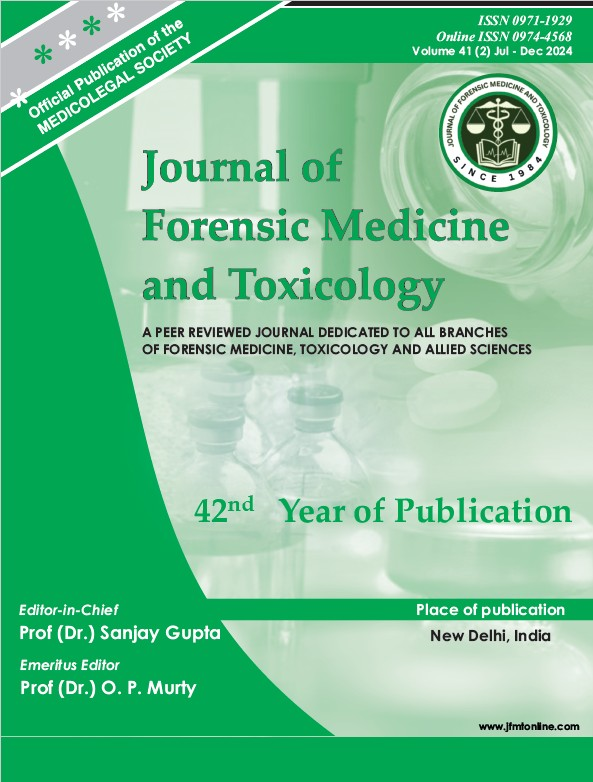EXTENSIVE FASCIOTOMY AND ESCHAROTOMY WOUND ARTEFACTS AT MEDICO LEGAL AUTOPSY: TWO CASE REPORTS
Keywords:
artefacts, disease, underwentAbstract
Therapeutic artefacts are commonlyobserved at routine autopsy by the forensic pathologist. It is mostlyproduced during resuscitation and medical intervention. We report two unusual therapeutic artefacts cases i.e. extensive fasciotomy and escharotomy wound artefacts at medico legal autopsy. Extensive fasciotomy was done as a therapeutic measure for compartment syndrome in Therapeutic artefacts;Extensive fasciotomy; 1 The deceased’s relatives are more artefacts. Some of the few artefacts resemble actual pathological or physiological features that could be very difficult to differentiate for even experienced forensic pathologists.2 We are reporting cases of therapeutic artefact due to fasciotomy and escharotomy wounds at autopsy,
Downloads
References
Saukko P, Knight B. In: The Forensic Autopsy. Knight’s Forensic Pathology. 4th ed. London:CRC press; 2016:98-101.
Forensic Pathology Principle and Practice. In. Artifacts of Resuscitation and Complications of Medical Therapy. 1st ed. Elsevier. 2005: 317
Matsen FA. Compartment syndrome: a unified concept. Clin Orthop. 1975; 113:8–14.
Matsen III FA, Krugmire Jr RB. Compartmental syndrome. Surg Gynecol Obstet. 1978; 147:943–9.
Janzing H, Broos P. Fasciotomies of the limbs: how to do it? Acta Chir Belg. 1998; 98:187–91.
BernotM, Gupta R, Dobrasz J, Chance B, Heppenstall RB, Sapega A. The effect of antecedent ischemia on the tolerance of skeletal muscle to increased interstitial pressure. J Orthop Trauma. 1996;10: 555–9.
Horwitz T. Ischemic contracture of the lower extremity. Arch Surg. 1940; 41:945–59.
Merle G, Harvey EJ. Pathophysiology of Compartment Syndrome. In Compartment Syndrome. Springer, Cham; 2019: 17-24.
Garner MR, Taylor SA, Gausden E, Lyden JP. Compartment syndrome: diagnosis, management, and unique concerns in the twentyfirst century. HSS J. 2014; 10:143–52.
Branco BC, Inaba K, Barmparas G, Schnüriger B, Lustenberger T, Talving P, et al. Incidence and predictors for the need for fasciotomy after extremity
trauma: a 10-year review in a mature level I trauma centre. Inj. 2011;42: 1157–63.
Ritenour AE, Dorlac WC, Fang R, et al. Complications after fasciotomy revision and delayed compartment release in combat patients. J Trauma. 2008;64:S153– 62.
Donaldson J, Haddad B, Khan WS. Suppl 1: the pathophysiology, diagnosis and current management of acute compartment syndrome. The open orthopedicsjournal. 2014;8:185.
Tornetta P 3rd, Puskas BL, Wang K. Compartment syndrome of the leg associated with fracture: an algorithm to avoid releasing the posterior compartments. J Orthop Trauma.2016;30(7):381–6.
Bowyer MW. Lower extremity fasciotomy: indications and technique. Current Trauma Reports. 2015 Mar 1;1(1):35-44.
Orgill DP, Piccolo N. Escharotomy and decompressive therapies in burns. J Burn Care Res. 2009 (5):759-68.
Aggrawal A. Thermal burns In: Textbook of Forensic Medicine and Toxicology.1st ed. New Delhi: Avichal publishing company; 2014: 259




